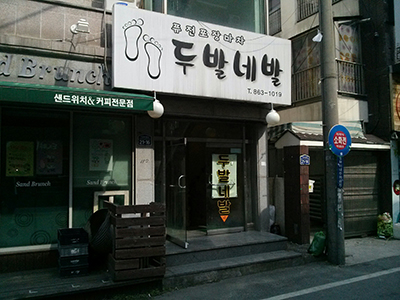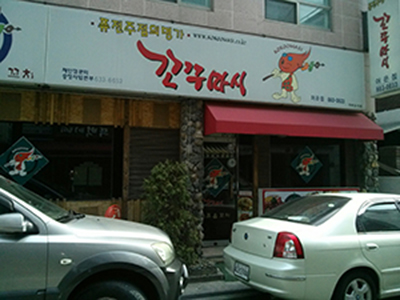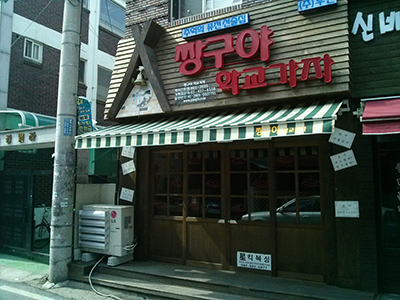Dubal Naebal

Translated as “Two Feet Four Feet” in English, Dubal Naebal conjures up images of students entering the pub sober standing on two feet and then crawling their way out using four feet after a night of heavy drinking. However, unlike this wild image that the name brings, the place is perfect for having a few drinks with a close group of friends in a warm and cozy atmosphere.
Located near the West Gate of KAIST, Dubal Nebal is one of the most popular bars in Eoeun-dong. The place oozes the atmosphere of a traditional Korean pub with its Korean cuisine and traditional interior, which includes round, wooden tables, chairs, and even floor seats in the corner. The place is known among KAIST students for its delicious side dishes. Here, pajeon with makgeolli is a must-try menu. It also offers a wide variety of drinks such as soju, makgeolli, chungha and maehwasu.
Kokoomasi

Most KAIST students will have visited Kokoomasi, one of the more popular establishments in Eoeun-dong, at least once during their time at school. According to the franchise website, the name Kokoomasi is apparently a contraction of the Korean phrase meaning “eat grilled skewers and drink.” The website also states that the wood interior helps create a peaceful and comfortable atmosphere, which is quite the opposite of the insane drinking that occasionally occurs in this place. The interior is mostly comprised of small tables that can seat four people (six if you squeeze together), although there are a few larger tables in the back.
Ironically, while skewers are supposed to be the main attractions, they don’t appear all that popular, due to their small servings and relatively high price, among the constantly hungry, cash-strapped college students who comprise the main customer base. Still, Kokoomasi offers a wide variety of foods to go with the alcohol, ranging from skewers to various fried foods to stews. Naengguksu (cold noodles), a more popular dish at this particular establishment, is actually not on the standard menu. Should you order one of these, you will be presented with enough food to feed a small family.
Of course, one cannot forget the ever-friendly owner who will always greet you as you enter. The lady seems to do everything from taking orders to preparing the food to working the register. If you visit the place frequently enough, she may even bring you complementary ramen noodles when asked politely.
The only downside to this place is that the food can take a relatively long time to be prepared, but they will bring you endless supplies of free gyeran jjim (steamed eggs), jeon (Korean pancakes), and cucumbers to keep you occupied.
JJang-Gu

Jjangguya Hakgyogaja (Jjanggu) is a themed Korean franchise bar that can be spotted on the right side of the road straight ahead from KAIST’s West Gate. The name literally translates to “Jjangu, let’s go to school” and is meant to induce nostalgia among those in their 30’s to 50’s. Naturally, the theme is Korean schools back in the old days. All the interior design has hints of old high schools: wooden tables, a black board and chalk, and a large weekly schedule (in Korean high schools, students used to have all their classes in the same room, to which the teacher of the subject matter would visit).
Interestingly, the owner of the KAIST branch claims to have specially modernized part of its interior to lower their target consumer: the students. In similar spirit, Jjanggu offers some unique treats, of which the two most interesting are jjanggubanhab and jjangsundosirak. They both resemble what students in the 70’s and 80’s would have taken to school for lunch. The prior serves hot noodles, boiled rice, plain egg (which used to be a sign of wealth), fried ham with egg layering, and kimchi; the latter serves the same, except with spicy beef and without the noodles. Unfortunately, the beverages offered are regular drinks that can be found in any other bars, so the merit of Jjanggu lies upon its rather exotic, perhaps nostalgic for some, atmosphere and dishes. All in all, Jjanggu is a place recommendable for both those who are used to such a place and those who have not been in Korea during those times but wish to experience something different.

